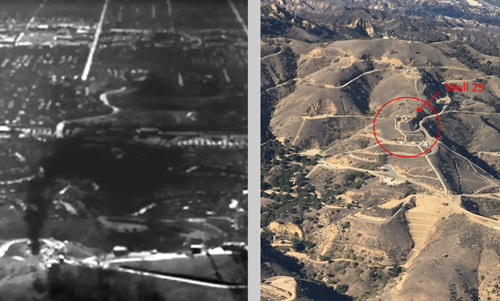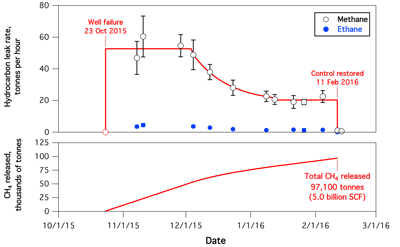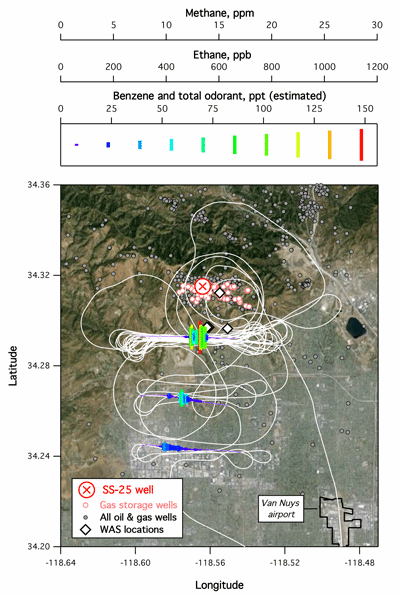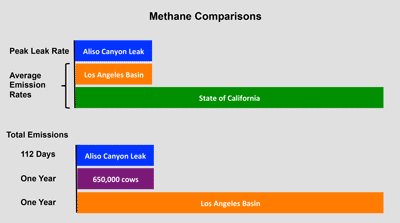2016 News & Events
California's Aliso Canyon blowout led to largest U.S. methane leak ever
25 February 2016

The first published study since the natural gas well was plugged shows the leak was equivalent to one-quarter of Los Angeles' annual methane emissions.
On February 11, workers in California ended one of the largest natural gas leaks in history, the Aliso Canyon leak that had been releasing methane and other gases into the atmosphere since October 23rd. The leak caused the evacuation of more than 5,000 households in Porter Ranch, a suburb northwest of Los Angeles.
Scientists in California and Colorado quickly joined forces to assess the atmospheric impacts of the leak, commencing airborne and ground measurements about two weeks after the blowout to quantify how much methane, a powerful greenhouse gas, was escaping. Scientists from the Chemical Sciences Division of NOAA's Earth System Research Laboratory and from Scientific Aviation (a research company in Boulder) co-led the Aliso Canyon Study.
The enormity of the methane leak surprised even the scientists. At its peak, the methane emission rate doubled that of the entire Los Angeles Basin. The findings are published in the February 25 issue of Science.

The scientists continued to make measurements as workers took steps to reduce the leak throughout recent months, until the leak was finally plugged. Their 13 research flights gave them an unprecedented "end-to-end" opportunity to document the total amount of methane that was released over the 112-day leak. The amount was over 100,000 tons of methane – one quarter of the methane that is typically emitted by the entire Los Angeles Basin over the course of a year.
"Our finding means that the Aliso Canyon leak was the largest accidental release of methane in the history of the U.S.," said Tom Ryerson, a scientist at the NOAA ESRL Chemical Sciences Division and co-lead of the study.
The Aliso Canyon gas leak will substantially impact California's ability to meet greenhouse gas emission targets for the year, according to the study's authors.
"The impact of the Aliso Canyon leak on climate will be equivalent to the annual greenhouse gas emissions from more than a half-million passenger cars," said study coauthor Jeff Peischl, a scientist with the Cooperative Institute for Research in Environmental Sciences at University of Colorado Boulder who works in the NOAA ESRL Chemical Sciences Division.
The 13 flights also were real-time snapshots of the effectiveness of mitigation measures taken by the Southern California Gas Company in December and January. After about December 1, the emission rate gradually fell from its peak of 50 tons of methane per hour to about 20 tons per hour, where it steadied until the successful intervention on February 11. The researchers relayed their findings to the California Air Resources Board throughout the leak.

Lead Author Stephen Conley, a scientist with Scientific Aviation and University of California Davis, gathered the airborne data using his single-engine Mooney TLS aircraft, carrying instruments that made real-time measurements of methane and ethane. On the ground near the well site, coauthor Donald Blake of University of California Irvine collected samples of the leaking natural gas to determine its composition and compare to Conley's airborne measurements. Using these samples, the researchers also could estimate the trace amounts of benzene, toluene, sulfur-containing odorants, and other constituents released during the leak. The estimates gave air quality and health officials a basis for gauging the levels of these other compounds in the impacted area.
The mega-leak has drawn attention to the broader problem of fugitive emissions from natural gas extraction and processing and from the pipelines and storage infrastructure across the country. The leaky well is one of 115 wells connected to this particular subsurface storage reservoir, which has been used for natural gas storage since 1973 and is the fourth largest facility of its kind in the U.S.
The new study highlights the value of responding rapidly with airborne chemical sampling during crises involving the development of energy resources. Such information can help to document human exposure, formulate optimal well control intervention strategies, quantify the effectiveness of deliberate control measures during well breaches, and assess the climate and air quality impacts of large unintended releases. The NOAA and CIRES researchers in the Aliso Canyon study also provided critical airborne measurements during the 2010 Deepwater Horizon Oil Spill in the Gulf of Mexico. Their work in the Gulf established that air quality was safe for relief workers and the public downwind, and also pioneered a new method of using airborne measurements to quantify the subsurface oil leak rate during offshore oil spills.
In the case of the Aliso Canyon leak, the researchers came together to make unprecedented measurements of the event from nearly its start until the leak was plugged.
"If we don't measure these things quickly, we won't have any idea of what kind of response might be called for," said Conley. "We're happy that we could provide state officials with the scientific information they needed."
The work was funded by the California Energy Commission, the Southern California Gas Company, the California Agricultural Experiment Station, and NOAA.
Stephen Conley (Scientific Aviation, Boulder, CO and University of California, Davis), Guido Franco (California Energy Commission), Ian Faloona (University of California, Davis), Donald R. Blake (University of California, Irvine), Jeff Peischl (University of Colorado CIRES and NOAA), and Thomas B. Ryerson (NOAA), Methane emissions from the 2015 Aliso Canyon blowout in Los Angeles, CA, Science, doi:10.1126/science.aaf2348, 2016.
Abstract
Single-point failures of the natural gas infrastructure can hamper deliberate methane emission control strategies designed to mitigate climate change. The 23 October 2015 blowout of a well connected to the Aliso Canyon underground storage facility in California resulted in a massive release of natural gas. Analysis of methane (CH4) and ethane (C2H6) data from dozens of plume transects from 13 research aircraft flights between 7 Nov 2015 and 13 Feb 2016 shows atmospheric leak rates of up to 60 metric tonnes of CH4 and 4.5 metric tonnes of C2H6 per hour. At its peak this blowout effectively doubled the CH4 emission rate of the entire Los Angeles Basin, and in total released 97,100 metric tonnes of methane to the atmosphere.
